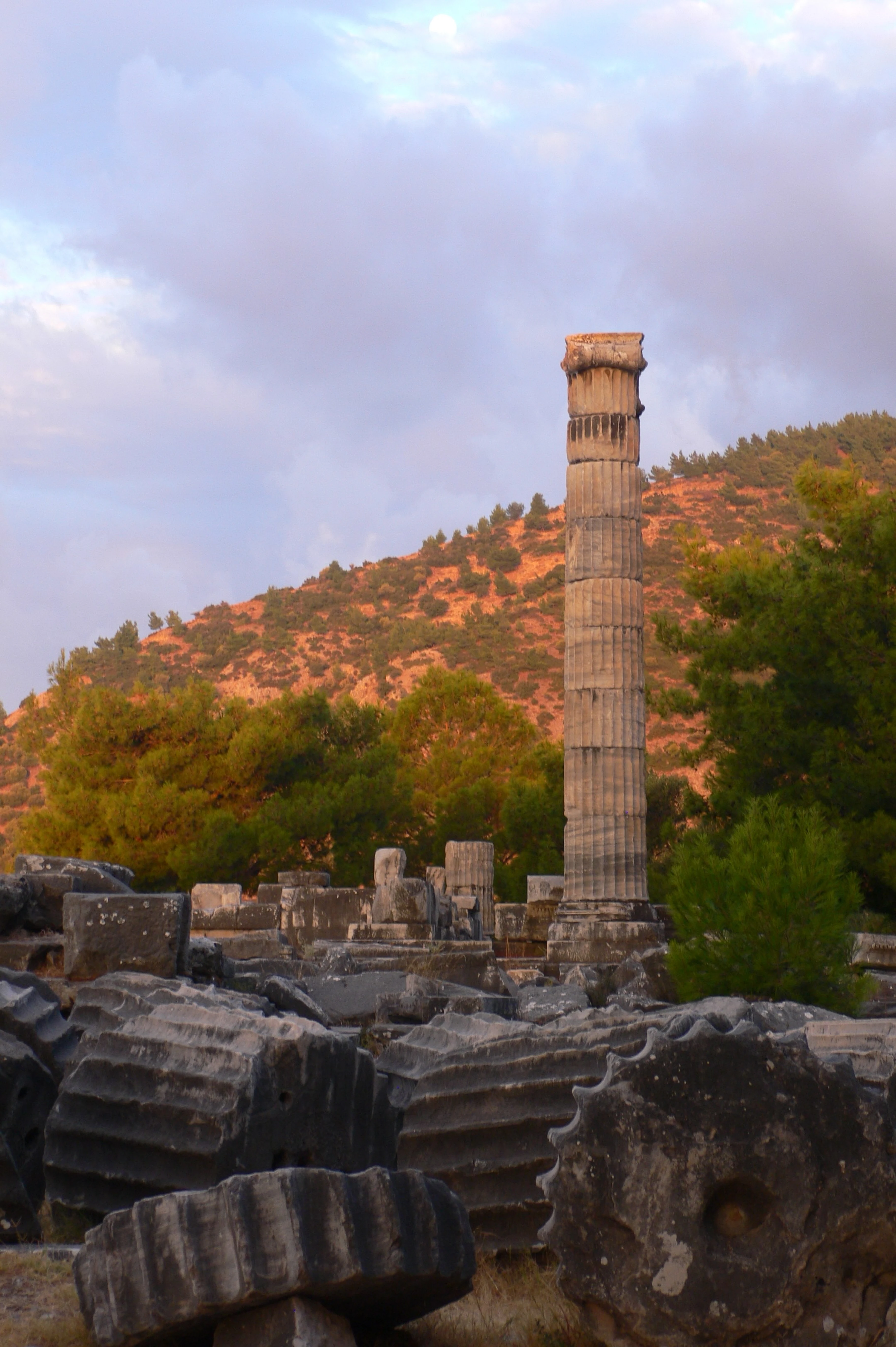
#Talk
Of columns, sun and frowns in Priene, or what archaeological research is all about
Every summer, a team from Goethe University Frankfurt performs archaeological work in an ancient city located on the western coast of Turkey. This is a place where others go on vacation – while we go there to dig, measure and reconstruct. We know exactly what it takes to perform an excavation!
Unser Projekt
Our project:
The research project at Goethe University Frankfurt is part of the international archaeological excavations in the ancient city of Priene, located in present-day western Turkey, near the Mediterranean coast. For 25 years, lecturers and students from Frankfurt have been involved in the project, which is led by a local team.
Priene is a Greek city that was built from scratch on a very steep slope of the Mycale Mountains around 350 BC. The city was built in a grid system; all residential areas and public spaces had fixed dimensions and proportions. Priene, whose width measures just 600 meters from west to east, was inhabited until the 14th century AD. The city’s structure underwent many changes over time, the religions practiced here shifted from the cults of the pagan gods to the Christian and Jewish faiths, while political dependencies also changed. The excavations allow us to gain a broad understanding of the inhabitants’ daily lives.
Financed by two smaller foundations, we are currently reconstructing parts of the larger hall buildings, measuring up to 120 meters, and also realizing a presentation of the city’s market square, once the region’s largest, in a manner that both preserves the historical monuments and structures the terrain. Just nine years ago, none of the ancient buildings were visible – they were covered and obscured by meter-high piles of stone debris. Since then, not only have large areas been cleared and trees felled, many walls and columns have been rebuilt, too.
Another project we are working on focuses on researching the northern, very steep strip of land located below the Acropolis rock face. Since 2020, we have been inspecting this terrain, which is covered by pine and holm oak trees and littered with small and very large boulders, which have fallen from the rocky slope over the centuries. To date, it was assumed that trees had been planted here in ancient times to protect against the rocks. However, our survey showed that there were in fact gardens located up here and houses in the lower zones. The ancient city’s effective surface and productive land were thus much larger than assumed and each campaign provides new details in the city plan.
Our team:
The international excavation team is made up of between 25-30 people, including students of archaeology and building research from many universities in Turkey and Germany (especially from Frankfurt), stone restorers, ceramic specialists and a surveyor. The languages spoken on site are Turkish, German and English. During the dig, some of us live in a house built 130 years ago. But since it has nowhere near enough rooms to accommodate us all, we also rent rooms in the area’s only guesthouse, and, more recently, have also been housing people in containers put up next to the excavation house. A cook and an assistant take care of our physical well-being. The working hours are long, often lasting into the night, and many times involve preparing the field work for the next day.
The research project is a great opportunity for students from Frankfurt to get a taste of what it is like to work at an archaeological site. And experience shows that once they're involved, they want to come back the next year... It's a focused life, without the major distractions that are otherwise part of everyday life in Germany. You learn things here that you don't learn at university, like: How do I recognize from three stones lying in the terrain whether they once belonged to a wall? From which period is this small shard? Are small finds like terracotta or metal objects part of the house inventory or are they perhaps consecration objects that were given to deities? How do you document what was found, and how does it all end up on the digital city map? What is it like to walk up and down slopes in the blazing sun at 35°C, laden with bulky equipment? In short – each day here takes us beyond our own comfort zones, but in an exciting manner!
Unser Team
Etwa 25 bis 30 Personen gehören zum internationalen Grabungsteam. Dazu zählen Studierende der Archäologie und Bauforschung von vielen Universitäten in der Türkei und Deutschland (besonders aus Frankfurt), Steinrestauratoren, Keramikspezialisten und ein Vermesser. Gesprochen wird Türkisch, Deutsch und Englisch. Gewohnt wird in einem Grabungshaus, das vor 130 Jahren gebaut wurde. Da dessen Zimmer aber bei weitem nicht ausreichen, mieten wir Zimmer in der einzigen Pension vor Ort an und bringen seit kurzem auch Personen in Containern neben dem Grabungshaus unter. Köchin und Helferin sorgen für das leibliche Wohl. Die Arbeitszeiten sind lang, oft wird bis in die Nacht ausgewertet und die Feldarbeiten des nächsten Tages vorbereitet.
Für die Studierenden aus Frankfurt ist es eine tolle Chance, in so ein Forschungsprojekt hineinschnuppern zu können. Und, wer einmal dabei, möchte im nächsten Jahr wieder mit … Es ist ein konzentriertes Leben, ohne große Ablenkungen wie sonst im deutschen Alltag. Hier lernt man Dinge, die im Studium nicht vorkommen. Wie erkenne ich bei drei im Gelände liegenden Steinen, ob es sich um eine Mauer handelt, aus welcher Zeit ist das kleine Scherbenfragment, gehören die Kleinfunde wie Terrakotten oder Metallobjekte zum Hausinventar oder sind sie vielleicht Weiheobjekte, die Gottheiten geschenkt wurden? Auf welche Weisen wird dokumentiert, was gefunden wurde, und wie kommt das alles dann in den digitalen Stadtplan? Wie ist es, bei 35 ° C die Hänge in der prallen Sonne rauf und runter zu laufen, beladen mit sperrigem Ausrüstungsmaterial. Kurz: Wir bewegen uns hier tagein, tagaus oft jenseits der Komfortzone, das aber mit viel Begeisterung!
